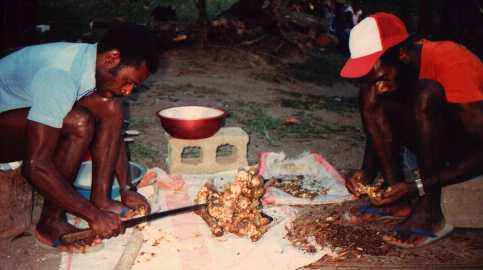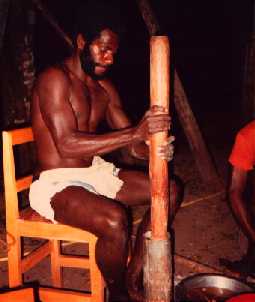
Kava is the recreational drug of choice in Vanuatu. Although it was not used in some parts of the archipelago before Western contact, kava drinking is an age-old tradition in most of Vanuatu. I was not a nightly kava drinker, as are many expatriates, but I did drink the occasional shell in village nakamals and at traditional ceremonies. I also had some familiarity with the commercial nakamals of Port Vila and Luganville.

Mature kava plant in a village garden. Photo ©S. Combs, 1987.
Kava is a drink prepared from the roots of the domesticated kava plant (piper methysticum), which is related to the pepper plant (the vine that provides peppercorns that are ground into black pepper). Unlike pepper, kava is a bush with branches that radiate up from a central mass of roots. Domesticated cultivars can only be propagated vegetatively, by planting pieces of stem back into the ground after a mature plant (two to five years old) has been harvested.
There are several different domesticated cultivars of kava. Some have stronger effects than others, and the effect of some is reputed to last longer (tu-dei kava). I have seen the results of scientific tests that show that different cultivars have different kava ketones (the active ingredient, a fat-soluble compound found within the root cells) that stay in the bloodstream different lengths of time.
It must be kept in mind that a great number of Vanuatu's villages comprise their own language groups with their own customs and traditions, and generalizations are dangerous. Nevertheless, it is safe to say that in those areas where kava use is traditional, only adult men may drink it. Many of them drink it every night. My wife and I were told in one village that kava drinking was not an old tradition there, and she was invited to join in that evening. Nevertheless, I suspect kava is not a regular woman's drink there, either.
In the towns of Port Vila and Luganville and to a lessor extent in Norsup and Lenekal, the only places where the money economy exists to any extent in Vanuatu, commercial nakamals (meaning "commercial kava bars" when used in town) are present. Women are allowed to drink kava here, as long as they are not from the same village as the nakamal owner.
How Is Kava Prepared and Drunk In the Villages?

Cutting and cleaning a kava root in an east Malekula village. Photo ©S. Combs, 1987.
In the villages, kava is always prepared from fresh roots. Each afternoon, someone digs up a root ball from his garden, replanting several of the stalks so that a perpetual supply is assured. He then shakes the soil off the root and carries it to the nakamal. About dusk, men start gathering, and one or two clean the roots, scrape the skin off, and cut the roots into small pieces about 2 cm. long. The root is then pulverized or ground by one of several methods, depending on the region.

Pounding kava. Photo ©S. Combs, 1987.
At some places, like Tanna, the kava is chewed and then spit out in wads. On Ambae and North Pentecost, it is ground in a man's hand by twisting a cylinder of coral in the opposite palm, which holds the root pieces. A common method elsewhere is to pound the kava in a cylindrical mortar with a heavy pestle. Mortars are made of hollowed wood or large pipe, and old WW II artillery shell casings are popular. A heavy straight length of tree branch or an old truck axle makes a good pestle.
Continue to Kava In Vanuatu - Part 2.
©Stan Combs, 1995